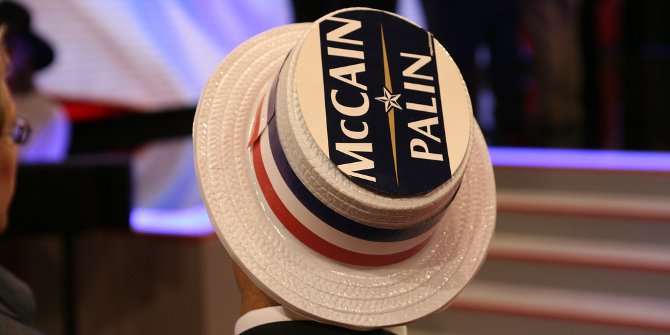 Donald Trump recently announced his list of potential vice-presidential running-mates, two of whom are from Florida. David Wise writes that given that Donald Trump is also a Florida resident, under the 12th Amendment of the Constitution, a vice-presidential pick from Florida would invalidate the state’s Electoral Votes if Trump were to win them. If the election was close, he writes, this could then throw the vice-presidential election to the US Senate, which could then see Donald Trump as President, and Kamala Harris as Vice-President.
Donald Trump recently announced his list of potential vice-presidential running-mates, two of whom are from Florida. David Wise writes that given that Donald Trump is also a Florida resident, under the 12th Amendment of the Constitution, a vice-presidential pick from Florida would invalidate the state’s Electoral Votes if Trump were to win them. If the election was close, he writes, this could then throw the vice-presidential election to the US Senate, which could then see Donald Trump as President, and Kamala Harris as Vice-President.
It is noon on January 20, 2025. Kamala Harris is sworn in for another term as Vice-President by Supreme Court Justice Ketanji Brown Jackson. Then Chief Justice John Roberts rises to administer the oath of office to the 47th President of the United States, Donald J. Trump. Yes, that could happen.
Donald Trump recently disclosed his short list of six individuals to be his vice-presidential running mate: former Congresswoman Tulsi Gabbard of Hawaii, Governor Kristi Noem of South Dakota, Senator Tim Scott of South Carolina, biotech entrepreneur Vivek Ramaswamy of Ohio, Governor Ron DeSantis of Florida, and Congressman Byron Donalds also of Florida. While DeSantis has since stated that he would not serve as Trump’s vice-president, and the Trump campaign has responded that the Florida governor was no longer in the running, we are still a long away from the summer when Trump will likely announce his vice-presidential pick, and much could change between now and then.
The problem with Florida
The problem with this list is that like DeSantis and Donalds, Donald Trump is also a resident of Florida. The election of the President and Vice-President are determined by the Electoral College, not by popular vote. The opening text of the 12th Amendment of the Constitution states, “The Electors shall meet in their respective states, and vote by ballot for President and Vice-President, one of whom, at least, shall not be an inhabitant of the same state with themselves.” This means that neither DeSantis nor Donalds could receive Florida’s 30 Electoral votes.
It takes 270 Electoral Votes to be elected to either of the two highest offices in the land. Since 1976 there have been several occasions when the winning candidate received fewer than 300 Electoral votes: Jimmy Carter in 1976 (297), George W. Bush in 2000 (271) and 2004 (286). The last two presidents have won with 306 Electoral Votes. Technically Trump was elected with 304 due to two so-called “faithless Electors” who refused to cast their ballots for the winner of their state.

“Vice Presidential podium” (CC BY-SA 2.0) by Gage Skidmore
In 2016 Donald Trump won by unexpectedly carrying three “blue wall” states” that had been considered untouchable, not least of whom by his opponent: Michigan, Pennsylvania, and Wisconsin. If Trump were able to put together the same coalition, but this time without carrying Wisconsin, he would still be elected, but this time with 296 Electoral Votes. The problem for either Governor DeSantis or Congressman Donalds is that Florida has 30 Electoral votes, leaving them with 266, four short of the 270 needed for them to become Vice-President.
The Senate steps in
This is the point at which another part of the 12th Amendment would come into play. According to that Amendment: “The person having the greatest number of votes as Vice-President, shall be the Vice-President, if such number be a majority of the whole number of Electors appointed, and if no person have a majority, then from the two highest numbers on the list, the Senate shall choose the Vice-President; a quorum for the purpose shall consist of two-thirds of the whole number of Senators, and a majority of the whole number shall be necessary to a choice.” In other words, only 51 Senators would be needed to choose the Vice-President.
To continue with this hypothetical, the Senate would have the choice between Kamala Harris, presuming that she will be the Democratic candidate for Vice-President, and either DeSantis or Donalds for the Republicans. If the Democratic Party holds onto the majority in the Senate, then Kamala Harris would begin her second term as Vice-President of the United States (current polling indicates that this year’s Senate elections may see the Democrats lose control of the chamber, but this is not a certainty).
There have only been two occasions when the election of the President and Vice-President hung in the balance. In 1796 John Adams, a Federalist, served with Thomas Jefferson, then called Democratic-Republican, as his Vice President. In 1800 Thomas Jefferson won in the House of Representatives after 36 ballots in the House of Representatives, oddly to break a tie between himself and the man who was supposed by his vice-presidential running mate, Aaron Burr. Both of these unusual outcomes were supposed to be remedied by the 12th Amendment, so it would be highly ironic if that same Amendment produced another mixed result.
The scenario above, while highly unlikely, is possible under the current rules of the game. Think that the election of 2024 can’t get any weirder? Think again.
- Please read our comments policy before commenting.
- Note: This article gives the views of the author, and not the position of USAPP – American Politics and Policy, nor the London School of Economics.
- Shortened URL for this post: https://wp.me/p3I2YF-dDL






